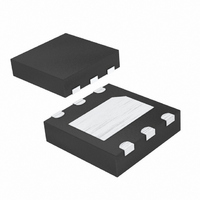MAX7394ATTZH+T Maxim Integrated Products, MAX7394ATTZH+T Datasheet - Page 6

MAX7394ATTZH+T
Manufacturer Part Number
MAX7394ATTZH+T
Description
IC OSCILLATOR PREC 6-TDFN
Manufacturer
Maxim Integrated Products
Type
Oscillator, Siliconr
Datasheet
1.MAX7394ALTTPT.pdf
(9 pages)
Specifications of MAX7394ATTZH+T
Frequency
40MHz
Voltage - Supply
2.4 V ~ 3.6 V
Current - Supply
12mA
Operating Temperature
-40°C ~ 125°C
Package / Case
6-TDFN Exposed Pad
Lead Free Status / RoHS Status
Lead free / RoHS Compliant
Count
-
The MAX7393/MAX7394 precision silicon oscillators
replace crystals, ceramic resonators, and crystal oscilla-
tor modules in systems with a +2.4V to +3.6V operating
supply voltage range. The MAX7393/MAX7394 consist of
a temperature-compensated precision oscillator with
enable (MAX7394) or autoenable (MAX7393). The
ENABLE input on the MAX7394 manually enables or dis-
ables the oscillator. The CLKIN input on the MAX7393
monitors a returned clock signal to automatically enable
or disable the MAX7393 oscillator.
The MAX7393/MAX7394 are supplied at specific frequen-
cies, like crystals and resonators. A variety of popular
standard frequencies are available (see the Selector
Guide). Output frequency accuracy is guaranteed to be
within ±0.25% (TDFN) and ±1.3% (µDFN) (0°C to +85°C)
and ±1.0% (TDFN) and ±1.8% (µDFN) over the -40°C to
+125°C temperature range. No external components are
required to generate the specific frequency.
The ENABLE input on the MAX7394 turns the oscillator
on and off. Drive ENABLE to a logic-high for normal
operation. Drive ENABLE to a logic-low to place the
device in shutdown mode. During shutdown, the oscilla-
tor is turned off, and the CLOCK output is weakly driven
high with an internal 10kΩ to V
the total supply current reduces to less than 2µA.
The MAX7393 features a CLKIN input that automatically
enables or disables the oscillator by sensing the condi-
tion of a returned clock signal. The MAX7393 is auto-
matically enabled whenever an active inversion function
is sensed between CLOCK and CLKIN. When no inver-
sion function is detected, the MAX7393 automatically
enters shutdown mode. During shutdown, the oscillator
is turned off, the CLKIN input is weakly driven to its last
state, and the CLOCK output is weakly driven to the
logic-level in CLKIN.
The CLKIN input relies on an external inversion func-
tion, typically provided by a microcontroller’s clock
generator, to provide an inverted version of the CLOCK
output signal. The MAX7393 interprets high/low voltage
or a constant high-impedance node on CLKIN as a
disable signal.
Figure 1 shows a test circuit to enable or disable the
MAX7393. One input of the NAND gate connects to the
CLOCK output of the MAX7393, and the other input is
driven with a logic level. A logic-high level enables the
oscillator and a logic-low level disables the oscillator.
See the Typical Operating Characteristics for typical
startup performance of the MAX7393.
Precision Silicon Oscillators with
Enable or Autoenable
6
_______________________________________________________________________________________
Autoenable (CLKIN, MAX7393)
Detailed Description
ENABLE (MAX7394)
CC2
. In shutdown mode,
The CLOCK output is a push-pull, CMOS logic output
that is capable of driving a ground-connected 1kΩ load
or a positive supply connected 500Ω load to within
300mV of either supply rail. There are no impedance-
matching issues when using the MAX7393/MAX7394
CLOCK output. A typical startup characteristic is shown
in the Typical Operating Characteristics.
The MAX7393/MAX7394s’ jitter performance is given in the
Electrical Characteristics table as a peak-to-peak value.
The MAX7393/MAX7394 CLOCK output is a push-pull,
CMOS logic output that directly drives any micro-
processor (µP) or microcontroller (µC) clock input. There
are no impedance-matching issues when using the
MAX7393/MAX7394. Operate the MAX7393/MAX7394
and microcontroller from the same supply voltage level of
V
more details). Refer to the microcontroller’s data sheet for
clock input compatibility with external clock signals.
The MAX7393/MAX7394 require no biasing compo-
nents or load capacitance. When using the MAX7393/
MAX7394 to retrofit a crystal oscillator, remove all bias-
ing components from the oscillator input.
The MAX7393/MAX7394 operate with power-supply
voltages in the +2.4V to +3.6V range. Connect V
V
receiving the clock. Proper power-supply decoupling is
required to maintain the power-supply rejection perfor-
mance of the MAX7393/MAX7394. Connect 0.1µF
surface-mount ceramic capacitors from V
GND. Position these bypass capacitors as close to V
and V
A larger V
if the MAX7393/MAX7394 are to operate with a large
capacitive load. Use a bypass capacitor value on V
at least 1000 times that of the output load capacitance.
Figure 1. Test Circuit to Enable or Disable the MAX7393 Oscillator
CC2
CC2
CC2
(see the Power-Supply Considerations section for
to the same supply voltage level as the device
CC2
as possible.
MAX7393
bypass capacitor value is recommended
Interfacing to a Microcontroller
Applications Information
Power-Supply Considerations
CLOCK
CLKIN
Oscillator (CLOCK)
ON/OFF
Output Jitter
Clock Input
CC
to V
CC
CC2
CC2
and
CC
to










